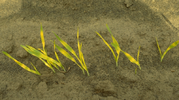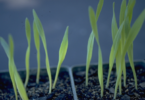International Database for Barley Genes and Barley Genetic Stocks
BGS 17, Chlorina seedling 4, fch4
Stock number: BGS 17
Locus name: Chlorina seedling 4
Locus symbol: fch4
Previous nomenclature and gene symbolization:
Chlorina seedling 4 = f4 (5, 8).
Yellow viable = yv (8).
Yellow viable = yv (8).
Inheritance:
Monofactorial recessive (8).
Located in chromosome 7HL (2, 3, 7, 8); fch4.g is slightly distal from the nud1 (naked caryopsis 1) locus (3); fch4.g is about 4.4 cM proximal from the lks2 (short awn 2) locus (3); fch4.g is associated with SNP marker 2_0042 (position 118.80 cM) in 7H bin 07 of the Bowman backcross-derived line BW360 (1); fch4.g is associated with SNP markers 1_0050 to 2_0042 (positions 87.33 to 118.80 cM) in 7H bins 06 to 07 of the Bowman backcross-derived line BW337 (1), in 7H bin 07.
Located in chromosome 7HL (2, 3, 7, 8); fch4.g is slightly distal from the nud1 (naked caryopsis 1) locus (3); fch4.g is about 4.4 cM proximal from the lks2 (short awn 2) locus (3); fch4.g is associated with SNP marker 2_0042 (position 118.80 cM) in 7H bin 07 of the Bowman backcross-derived line BW360 (1); fch4.g is associated with SNP markers 1_0050 to 2_0042 (positions 87.33 to 118.80 cM) in 7H bins 06 to 07 of the Bowman backcross-derived line BW337 (1), in 7H bin 07.
Description:
Seedlings are bright yellow-green on emergence and maintain this color until they are nearly mature. Seedlings and plants are relatively vigorous, but heading is delayed (8). Bowman backcross-derived plants with fch4.g gene, BW360, showed a 7 to 11 day delay in heading and are about 10% taller than Bowman. Spikes have one or two more kernels, kernels are slightly thinner and kernel weights were reduced by 10 to 20%, test weights were slightly lower, and grain yields were about half that of Bowman (4).




Origin of mutant:
A beta-ray induced mutant in Montcalm (CIho 7149) (8).
Mutational events:
fch4.g (Alb Acc 258, GSHO 1214) in Montcalm (CIho 7149) (8).
Mutant used for description and seed stocks:
fch4.g (GSHO 1214) in Montcalm; fch4.g in Bowman (PI 483237)*7 (GSHO 1851, BW360, NGB 20599); fch4.g in Bowman (PI 483237)*7 (BW337, NGB 22132).
References:
1. Druka, A., J. Franckowiak, U. Lundqvist, N. Bonar, J. Alexander, K. Houston, S. Radovic, F. Shahinnia, V. Vendramin, M. Morgante, N. Stein, and R. Waugh. 2011. Genetic dissection of barley morphology and development. Plant Physiol. 155:617-627.
2. Eslick, R.F. 1976. Approximate position of the chlorina mutants f4f4 and f8f8 on chromosome 1. Barley Genet. Newsl. 6:10-13.
3. Fedak, G., T. Tsuchiya, and S.B. Helgason. 1972. Use of monotelotrisomics for linkage mapping in barley. Can. J. Genet. Cytol. 14:949-957.
4. Franckowiak, J.D. (Unpublished).
5. Robertson, D.W. 1964. New genes in barley with their relation to linkage groups and chromosomes. p. 159-180. In S. Broekhuizen, G. Dantuma, H. Lamberts, and W. Lange (eds.) Barley Genetics I. Proc. First Int. Barley Genet. Symp., Wageningen, 1963. Centre for Agricultural Publications and Documentation, Wageningen.
6. Robertson, D.W., G.A. Wiebe, R.G. Shands, and A. Hagberg. 1965. A summary of linkage studies in cultivated barley, Hordeum species: Supplement III, 1954-1963. Crop Sci. 5:33-43.
7. Tsuchiya, T. 1972. Cytogenetics of telotrisomics in barley. Barley Genet. Newsl. 2:93-98.
8. Walker, G.W.R., J. Dietrich, R. Miller, and K. Kasha. 1963. Recent barley mutants and their linkages II. Genetic data for further mutants. Can. J. Genet. Cytol. 5:200-219.
2. Eslick, R.F. 1976. Approximate position of the chlorina mutants f4f4 and f8f8 on chromosome 1. Barley Genet. Newsl. 6:10-13.
3. Fedak, G., T. Tsuchiya, and S.B. Helgason. 1972. Use of monotelotrisomics for linkage mapping in barley. Can. J. Genet. Cytol. 14:949-957.
4. Franckowiak, J.D. (Unpublished).
5. Robertson, D.W. 1964. New genes in barley with their relation to linkage groups and chromosomes. p. 159-180. In S. Broekhuizen, G. Dantuma, H. Lamberts, and W. Lange (eds.) Barley Genetics I. Proc. First Int. Barley Genet. Symp., Wageningen, 1963. Centre for Agricultural Publications and Documentation, Wageningen.
6. Robertson, D.W., G.A. Wiebe, R.G. Shands, and A. Hagberg. 1965. A summary of linkage studies in cultivated barley, Hordeum species: Supplement III, 1954-1963. Crop Sci. 5:33-43.
7. Tsuchiya, T. 1972. Cytogenetics of telotrisomics in barley. Barley Genet. Newsl. 2:93-98.
8. Walker, G.W.R., J. Dietrich, R. Miller, and K. Kasha. 1963. Recent barley mutants and their linkages II. Genetic data for further mutants. Can. J. Genet. Cytol. 5:200-219.
Prepared:
T.E. Haus. 1975. Barley Genet. Newsl. 5:98.
Revised:
T. Tsuchiya. 1980. Barley Genet. Newsl. 10:103.
J.D. Franckowiak and A. Hang. 1997. Barley Genet. Newsl. 26:63.
J.D. Franckowiak. 2013. Barley Genet. Newsl. 43:54-55.
J.D. Franckowiak and A. Hang. 1997. Barley Genet. Newsl. 26:63.
J.D. Franckowiak. 2013. Barley Genet. Newsl. 43:54-55.
